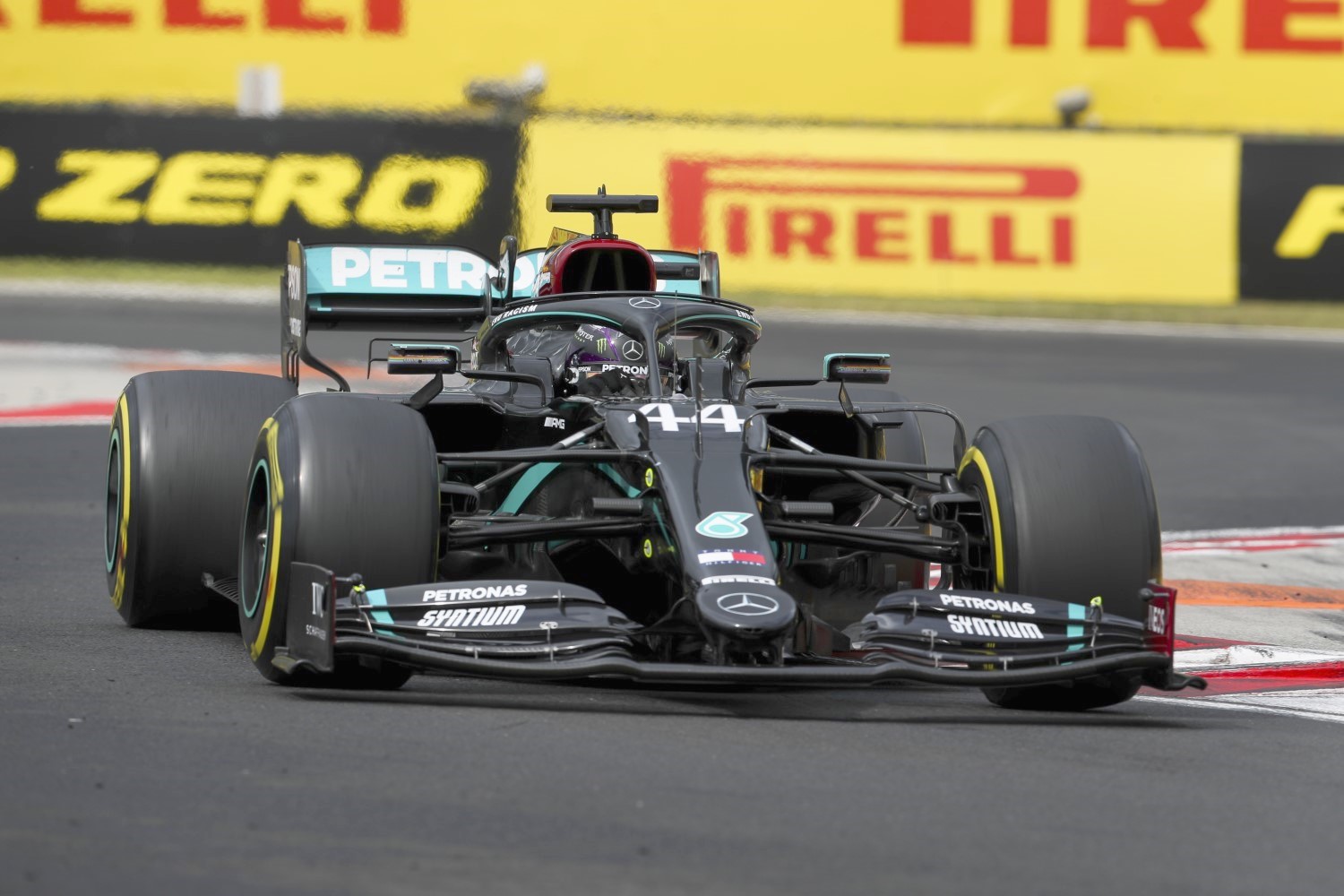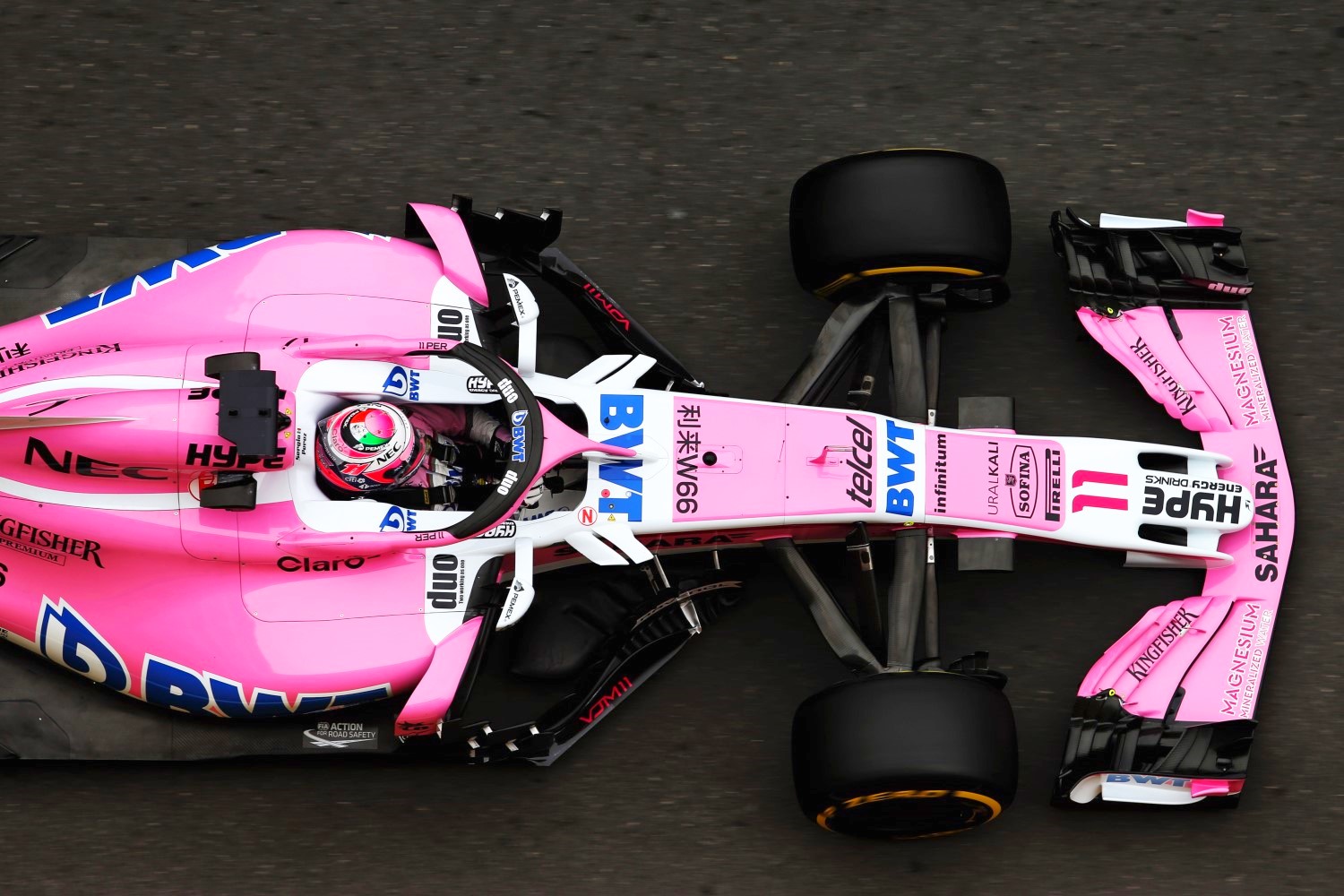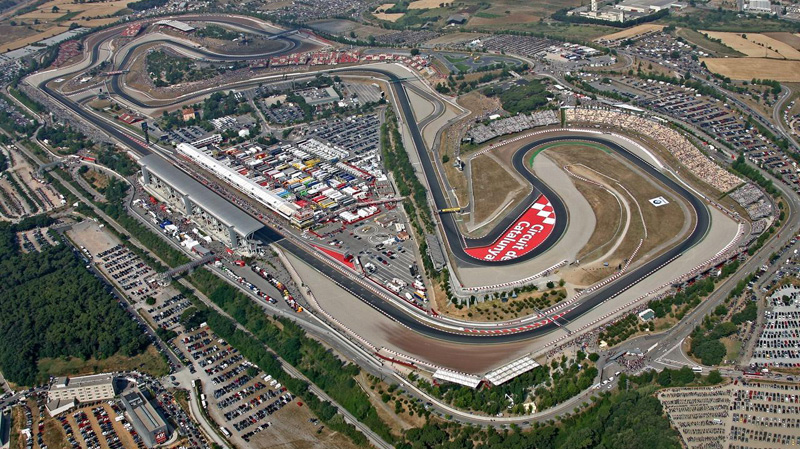Spanish GP Preview
 |
| Barcelona from the air |
The second triple-header of this frenetic Formula 1 season comes to an end with this Sunday’s 50th Spanish Grand Prix. The race takes place at the Barcelona-Catalunya Circuit, one of the tracks best known to the drivers who generally rack up a huge mileage here in testing.
The track. The track boasts a mix of high, medium and low speed corners, with several direction changes, some climbs and drops and a long main start-finish straight and thus provides a real test of a car’s abilities. The final part used to be high speed, but now features a slow chicane leading onto the straight. Of the permanent tracks, this is one of the hardest when it comes to overtaking. With the sea and mountains nearby, changing wind direction can be tricky to contend with as it upsets car balance considerably. This year, the race is being held in the height of summer, rather than usual spring date, so air and track temperatures will be much higher. Pirelli is supplying the same three tire compounds as those used at the first Silverstone race.
Each racing circuit is unique, like a fingerprint. Every venue has its defining characteristics, the elements that make it what it is, whether it is a set of corners, a set-up quirk or an architectural feature: in the cockpit, or walking through the paddock, this something is what reminds you, constantly, where you are.
Racing drivers, creatures of habit as they are, are very good at grasping what makes each track special. They feel it more than us common people, they adapt to it in the search of performance: as the years go by, each track forms an imprint in their brain, something they recall each time the visor is lowered. A head start, you may call it.
This is all the more true for Barcelona. Of all the tracks that make up the modern Formula One calendar, none is more so deeply ingrained in a driver’s psyche than the Circuit de Barcelona-Catalunya. Day after day of winter testing, every mile pounded into the track leaves its mark. Just as water slowly carves a path through stone, so does this track embed itself in a driver’s mind – every corner, every inch of tarmac.
The uphill, never-ending turn three, the fast turn nine, flat in qualifying with sparks sent flying into the sky, the final chicane, deceptively easy: a driver could drive the length of the circuit in a blindfold, so much it is second-nature to them.
History

Mario Andretti winnning the race in his Lotus 79 Ford.
The first Spanish Grand Prix to count towards the Formula 1 World Championship was held in 1951 at Pedralbes, near Barcelona, and has been a regular fixture since 1968. Ferrari has won this event 12 times, the first dating back to 1954 at Pedralbes courtesy of Mike Hawthorn in the 553 F1. The race has also been held at Jarama, in the Madrid area, which brought Ferrari wins for Niki Lauda in 1974 and Gilles Villeneuve in 1981, the Canadian keeping a pack of cars behind him so that the first five crossed the line covered by just 1.24 seconds. Then came Montjuich, also in Barcelona, Jerez de la Frontera, where Alain Prost won in 1990 in an F1-90, and, as from 1991, always at Montmelo. Michael Schumacher won here five times, in 1996 and from 2001 to 2004, Felipe Massa in 2007, Kimi Raikkonen in 2008 and Fernando Alonso in 2013.
Fact File: Spanish Grand Prix
- The Circuit de Barcelona-Catalunya covers a wide range of car speeds and corner types. The car is put through its paces in the slow corners at Turn 10, Turn 14 and Turn 15 (testing its mechanical grip), while also having to tackle the high-speed Turn 3 and Turn 9 (where the car’s aerodynamic grip is put to the test). It’s this variety that makes the track ideal for testing an F1 car.
- The high-speed corners at the Spanish GP venue are right-handers while the low-speed corners are left-handers. That impacts the car set-up, with different set-ups being used on the left and right-hand sides of the car to accommodate for this.
- The directions of the high and low-speed corners mean that the left tires wear out quicker while the right tires typically experience lower temperatures.
- Overtaking is particularly tricky in Spain. Drivers enter the track’s only long straight via a high-speed corner (Turn 16). That makes it difficult to follow the car in front closely as the second car loses aerodynamic grip in the “dirty air” from the car in front. The end of the straight is also tricky for overtaking, as Turn 1 is a medium-speed corner that doesn’t require much braking energy.
- 21 of the 29 races that have taken place at the Barcelona track have been won from pole position – emphasizing just how important Qualifying is at the Spanish GP.
- Turn 5 is a unique challenge for drivers as they tend to tackle the corner differently between Qualifying and the race. The camber of the road drops away at the apex of that corner, which unloads the inside-front tire and increases the risk of locking up. Drivers take this risk in Qualifying and use a tighter line, closer to the apex, as it’s a shorter distance. However, on a longer race stint, locking up can cause vibrations and risk additional pit stops. So, drivers typically take a wider line to keep the load on the inside-front and reduce the chance of locking up.
- The wind often changes direction during the course of the day in Spain, which impacts car balance. There is typically a tailwind on the main straight in the mornings, which produces a headwind into the high-speed corners and provides good car stability. It tends to rotate in the other direction in the afternoon or evening, which produces a tailwind into the high-speed corners and makes the balance very tricky.
- Sector three is the most important sector when it comes to lap time, because the drivers can find the most time in the low-speed corners. This makes it rare to see the same driver set three purple sectors in Barcelona, because maximizing the grip to be quick in sector one will lead to the tires being too hot by the time the driver reaches sector three.
- The distance between pole position and the first braking zone (Turn 1) at the Circuit de Barcelona-Catalunya is the fourth longest in F1, measuring 612.5 meters – only Russia, Mexico and Silverstone are longer.
- Barcelona has one of the lowest maximum speeds in F1, with cars reaching 320 km/h on the main straight due to its high-downforce nature. Only Hungary and Monaco register lower maximum speeds.
- The Circuit de Barcelona-Catalunya has the fourth-highest average track temperature in F1 at 41°C (calculated by a five-year mean). There’s two main factors for this: The track surface in Barcelona is very absorbent to heat, but the solar radiation (electromagnetic radiation emitted by the sun) is also particularly high in Barcelona, so the track temperature increases quickly when there is no cloud cover.
- This year marks the 50th running of the Spanish Grand Prix as part of the Formula One World Championship. It’s also the 30th Spanish GP to be held at the Circuit de Barcelona-Catalunya.
2020 Spanish Grand Prix – Stat Sheet
| Circuit Characteristics | 2019 Statistics | ||
| Circuit Length | 4.655 km | Fastest Lap FP1 | 1:17.951 (BOT) |
| Race Laps | 66 | Fastest Lap FP2 | 1:17.284 (BOT) |
| Race Distance | 307.1 km | Fastest Lap FP3 | 1:16.568 (HAM) |
| Number of Corners | 16 (7 L / 9 R) | Fastest Lap Q1 | 1:16.979 (BOT) |
| Distance from Pole to First Braking Zone | 612.5 m | Fastest Lap Q2 | 1:15.924 (BOT) |
| Pole Position Side | Left | Fastest Lap Q3 | 1:15.406 (BOT) |
| Pit Lane Length Under Speed Limit Control | 368.2 m | Delta FP1 to Q3 | -2.545s |
| Drive-Through Time at 80 km/h | 16.6s | Delta Q1 to Q3 | -1.573s |
| Lap Time at Full Throttle | 67% | Podium | HAM / BOT / VER |
| Lap Distance at Full Throttle | 76% | Team Result | HAM P1 / BOT P2 |
| Gear Changes Per Lap | 44 | Fastest Race Lap | 1:18.492 (HAM) |
| Braking Events (>2G) | 6 | Winning Race Time | 1:35’50.443 |
| Heavy Braking Events (<0.4s @ >4G) | 2 | Winning Average Speed | 192.3 km/h |
| Fuel Consumption | High | Qualifying Speed Trap | 325 km/h (LEC) |
| Maximum Lateral G-Force | 4.5 (T9) | Race Speed Trap | 338 km/h (NOR) |
| Maximum Speed | 320 km/h | Winning Strategy | 2 Stop (L27 / L46) |
| Track Evolution (P1 – Qualifying) | Medium | Total Pit Stops | 37 |
| DRS Zone | T9-10 / T16-1 | Total Normal Overtakes | 7 |
| Key Overtaking Opportunities | T1 / T10 | Total DRS Overtakes | 15 |
| Race Lap Record | 1:18.441 (RIC, 2018) | Not Classified (Accident / DSQ) | 2 |
| Absolute Lap Record | 1:15.406 (BOT, Q3, 2019) | Not Classified (Mechanical) | 0 |
| Race Characteristics (2015-2019) | |||
| Races Featuring Safety Car | 3 / 5 | Average Track Temperature | 41°C |
| Total Safety Car Deployments | 3 | Maximum Track Temperature | 49°C |
| Safety Car Probability | 60% | Wet Sessions | 0 / 25 |
| Safety Car Ratio | 0.60 | Wet Session Probability | 0% |
| Average Ambient Temperature | 23°C | Ambient Pressure | 1006 hPa |
| Maximum Ambient Temperature | 31°C | ||
| Tire Allocation | |
| Compound | Sets Per Driver |
| Soft | 8 |
| Medium | 3 |
Select Quotes
Toto Wolff
The 70th Anniversary Grand Prix was a good reminder how unpredictable and challenging our sport is and how difficult it is to win a race. You need to get absolutely everything right to beat your opponents – and we didn’t do that last weekend. We were quick in Qualifying, but the points are given out on Sunday and that’s when we struggled. We got beaten fair and square by Red Bull, and hats off to them again for the job they did.

Our team has always shown its greatest strengths when it was faced with tough and unexpected challenges – this week was no exception. We were clearly the outliers with regards to our tire blistering and it was important to find out what exactly caused it and what we can do to mitigate it in the future. We used the last few days to build a better understanding of the problem and translate that into ways to address it in the future.
Our next stop takes us to Barcelona, a track that we know better than any other circuit on the calendar. However, we usually go to Spain for winter testing and in spring weather for the first race of the European season. This year, we’re facing the heat of August with air temperatures of 30 degrees and more, in clear sunny skies. Our relative performance seems stronger in slightly cooler conditions, so the heat will definitely make it more challenging, but we’re excited to get back on track and find out if we’ve made a step in the right direction.
Sergio Perez
Q: What’s the main challenge of Barcelona?
SP: “Barcelona really tests the characteristics of your car. If you’re fast in Barcelona, you can be fast anywhere – that’s what makes it such a good place to hold pre-season testing. But we obviously have different challenges and conditions on a race weekend compared to testing. It’s also usually where most teams bring upgrades to their cars, so it can also affect relative performance to your rivals.

Q: Do you feel like you have extra support in Spain thanks to your common language?
SP: “I definitely feel the support of the local fans. It’s a great motivator and I’m very grateful for that. They always make me feel at home, too. It’s a shame the fans can’t be there this weekend – but I hope they enjoy following the weekend from home.”
Q: How have the past two weeks been for you and how are you feeling heading into the weekend?
SP: “Firstly, I’m very lucky that I’ve only had mild symptoms, so I’ve been able to keep training and make sure that I’m ready to jump back behind the wheel of the car. I’m very glad I had my tablet to keep me entertained too, though! I’ve definitely missed racing and it was hard to watch from the outside. I can’t wait to get on track, hopefully this weekend.”
Lance Stroll
Q: What do you enjoy most about visiting Barcelona?
LS: “I know Barcelona really well. It’s such a great place to visit. The weather is always amazing, the food is incredible, and you’ve got the nice beaches too. We obviously won’t be able to explore as we usually do – but hopefully we’ll have some fun on track to make up for it.”
Q: Like all Formula 1 drivers, you must know the circuit like the back of your hand?
LS: “We certainly get plenty of mileage across the weekend and pre-season testing! It’s definitely a familiar circuit and that means everyone will be closely matched in terms of lap time, so it’s about extracting every last tenth from yourself and the package to get a good result.”
Simone Resta Head of Ferrari Chassis Engineering
“We arrive in Barcelona knowing this will not be an easy weekend for us, given how testing went here in February. However, over the five races run so far, we have worked hard to try and improve our car’s performance and extract all its potential.
We will obviously encounter much hotter weather with track temperatures expected to be well above 40°C: it will be an important factor, especially when it comes to the behaviour of the tyres, as we saw at the last two races in Silverstone.
There will be no particular updates on the SF1000, however Sebastian will have a new chassis, because after the Silverstone post-race analysis, we spotted a small fault caused by a heavy impact over a kerb. It would not have had much of an effect on performance, but it was the logical decision to take. ”
Sebastian Vettel
“When you get to the Barcelona track you already know it will be a race where it’s the small details that make the difference. The teams and drivers all know this track very well and that’s why, right form the start of Friday free practice, you can work on fine tuning the car.
This circuit is quite different to Silverstone and I am curious to find out how the car will feel here. We can expect very high temperatures and so it will be important to find a set-up that allows you to have good speed without causing excessive tyre wear.”
Charles Leclerc
“The Barcelona track is a classic. Every year we do so many kilometres here in testing and therefore we can say it has no secrets. However, this year, as we will be racing here in the height of summer it will be interesting to see how our car performs in really hot weather.
As was the case in the two Silverstone races, I thing tyre management will be very important. It’s something we worked on a lot and in England it paid off. It will be important not to make any mistakes in qualifying to try and get the most out of the car in race configuration.”
